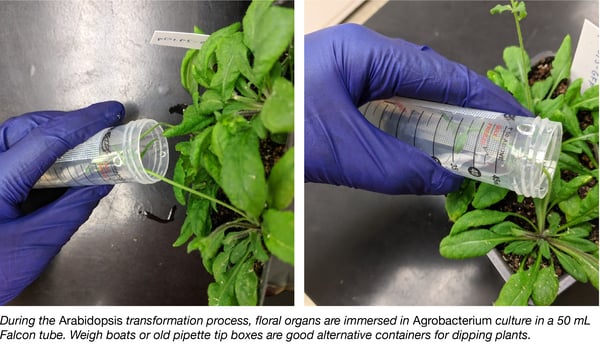This post was contributed by Laura Lee, a graduate student at Stanford University.
Arabidopsis is a fantastic model organism for many reasons, not the least of which is ease of transformation. There are many motivations to generate transgenic Arabidopsis, from studying transcriptional and translational dynamics of genes and proteins in living plants, to complementing mutant phenotypes. Arabidopsis is amenable to the floral drip or dip transformation method. The general steps for this method include:
- Cloning and transforming a plasmid into the bacterium Agrobacterium tumeficans - a plant pathogenic species that stably integrates transfer DNA (tDNA) into the genomes of the plants it attacks
- Growing the transformed agrobacterium culture
- Dipping your plant’s flowers in the agrobacterium culture to allow for tDNA insertions into the plant’s germline
- Selecting for seeds that have the tDNA insertions (usually via seed growth on antibiotic-containing media)
A similar process occurs in nature; Agrobacterium tDNA insertion likely precipitated domestication of sweet potatoes (Kyndt et al., 2015)! It sounds simple, and it pretty much is, but there are some tips and tricks you can use to obtain optimum transformation efficiency. It can take 6-8 weeks from the date of transformation to having an analyzable transgenic in hand, so it is pretty important to get this process right the first time. I’ll lay out some guidelines here. A detailed transformation protocol, as well as protocols for growing Arabidopsis are also available (Weigel and Glazebrook, 2002).
Find plant plasmid resources at Addgene
Choosing an expression system
Choosing an appropriate expression vector is the first step in generating transgenic Arabidopsis. There are a bunch of great options, but here are a couple of my favorites. Plasmids from the Tsuyoshi Nakagawa lab are binary gateway vectors and can be used for promoter swapping and generating N and C terminally tagged fusion proteins with fluorescent (YFP, GFP, CFP, RFP, etc.) or affinity tags (HA, FLAG). There are also a variety of plant selection markers (basta, hygromycin, kananamycin, tunicamycin) (Nakagawa et al., 2007). Alternatively, if you prefer Golden Gate assembly, there are a series of plasmids from the Dinneny lab that additionally allow for visual selection of transformants based on expression of RFP in the seed (Emami, Yee and Dinneny, 2013).
Preparing plants for transformation
Whatever plants you are transforming into will be your T0 generation. These plants will be ready to transform when they begin flowering. It is important to perform the transformation not long after flowering begins. If your plants begin to flower before your constructs are ready for transformation, you can cut off the primary inflorescence (the flowering portion of the plant) near the base of the stem. This buys you a few days until new inflorescences begin to grow. This will also increase the number of inflorescences overall, which may improve transformation efficiency. If you see many mature siliques (seed pods), your plants may be too old to transform. This transformation could still work, but the efficiency will be low.
Tips:
- Use healthy plants: Your plants should show no signs of stress, such as anthocyanin production, or disease, such as fungal growth. Healthy plants produce lots of seeds. More seeds mean more chances to recover a transformant.
- Use young plants: If you transform early, your plants will still have plenty of time to produce seeds after you expose the flowers to Agrobacterium. More seeds mean more chances to recover a transformant.
- Use lots of plants: Lots of plants produce lots of seeds. I typically use 8-10 plants per construct I transform. More seeds mean more chances to recover a transformant.
- Remove mature siliques prior to transformation: Siliques that are mature prior to transformation are just full of seeds that you know won’t harbor your transgene. You can optionally remove them to reduce the number of non-transformed seeds from the pool you will be selecting from later.
The Arabidopsis transformation process
The process itself is straightforward. When your agrobacterial cultures are ready, spin them down and resuspend them in transformation media. If you are dipping your plants, put the culture into a container that is wide enough to dunk your plant’s flowers inside. 50 mL falcon tubes or plastic weigh boats are both great options for this, depending on the volume of culture you chose to work with. You will get Agrobacterium all over your gloves, so be sure to change gloves between constructs if you are transforming more than one construct at a time.

For detailed protocols, volumes, spin speeds, recipes, and Agrobacterium strains see Weigel and Glazebrook, 2002.
Tips:
- Do a colony PCR on your agrobacterium: Getting a transformant takes a long time. Make sure the agrobacterial culture you are growing definitely contains your plasmid.
- Grow lots of Agrobacterium: The more agrobacterium you expose the plant to, the more likely you are to get a transformant. I like to spin down 100 mL of culture and resuspend in 25 mL of transformation medium per Agrobacterium strain. Additionally, the transformation process can get a bit messy, so you want to make sure you have sufficient volume to dip all your plants.
- Make sure your Agrobacterium cultures are not oversaturated: Agrobacterium needs to be alive to infect your plants. If your cultures have been incubated at stationary phase for too long, the cells in your culture will no longer be viable. The time this will take depends on the volume of culture you are using and whether you are inoculating from a frozen stock or a colony from an LB plate. In my hands, a 5 mL starter culture inoculated from a colony on a plate will reach an optimal density in 18-24 hours. I then add 0.5 mL of this starter culture to 100 mL fresh media, which is then ready to use in a transformation in another 24 hours. The remaining starter culture can be used for colony PCR and glycerol stocks.
- Dip/drip plants more than once: Dip your plants, let them recover for a week, and then dip them again. This won’t hurt them, and it will increase the chances of tDNA integration.
Selecting Arabidopsis transformants
Once your seeds from your T0 plants are dry, it’s time to select for transformants. It’s very important to select multiple T1 plants from each transformation. I like to isolate a minimum of five. You have no control over how many insertions occurred. Having too many insertions can cause artifacts from over-expression and it is likely that such a construct will be silenced in subsequent generations. You will know if you obtained a transformant with a single insertion because it will segregate 3:1 in the T2 generation. You also have no control over where your construct will be inserted. If your insertion occurs in a coding region, it may cause unexpected phenotypes. For most phenotypic analysis it is appropriate to begin working in the T2 generation. The selection process itself can affect the growth of resistant plants so you’ll want to know the effect of your insertion in the absence of selection.
For a protocol for antibiotic selection, check out Harrison et al., 2006.
Tips:
- Don’t plate seeds too densely during selection: this will increase background growth of non-transformants and make finding true transformants more difficult.
- Don’t leave your plants on selective plates for too long: even resistant plants will be affected by the selection eventually.
- Genotype putative T1 transformants: When your T1 is on soil and has recovered from the stress of selection you can clip a leaf and extract genomic DNA for genotyping. This won’t hurt your plant and it’s much easier to genotype in T1 than T2. Your transgene should not segregate in T1, but it probably will in T2.
 Laura Lee is a graduate student at Stanford University. She studies cell fate maintenance in the stomatal lineage and has made countless transgenic plants in the process.
Laura Lee is a graduate student at Stanford University. She studies cell fate maintenance in the stomatal lineage and has made countless transgenic plants in the process.
References
1. Emami, S., Yee, M. and Dinneny, J. R. (2013) ‘A robust family of Golden Gate Agrobacterium vectors for plant synthetic biology’, Frontiers in Plant Science, 4. doi: 10.3389/fpls.2013.00339. PubMed PMID: 24032037. PubMed Central PMCID: PMC3759027.
2 Harrison, S. J. et al. (2006) ‘A rapid and robust method of identifying transformed Arabidopsis thaliana seedlings following floral dip transformation’, Plant Methods. BioMed Central, 2(1), p. 19. doi: 10.1186/1746-4811-2-19. PubMed PMID: 17087829. PubMed Central PMCID: PMC1636043.
3. Kyndt, T. et al. (2015) ‘The genome of cultivated sweet potato contains Agrobacterium T-DNAs with expressed genes: An example of a naturally transgenic food crop.’, Proceedings of the National Academy of Sciences of the United States of America. National Academy of Sciences, 112(18), pp. 5844–9. doi: 10.1073/pnas.1419685112. PubMed PMID: 25902487. PubMed Central PMCID: PMC4426443.
4. Nakagawa, T. et al. (2007) ‘Improved Gateway Binary Vectors: High-Performance Vectors for Creation of Fusion Constructs in Transgenic Analysis of Plants’, Bioscience, Biotechnology, and Biochemistry, 71(8), pp. 2095–2100. doi: 10.1271/bbb.70216. PubMed PMID: 17690442.
5. Weigel, D. and Glazebrook, J. (2002) Arabidopsis : a laboratory manual. Cold Spring Harbor Laboratory Press. Available at: https://books.google.at/books/about/Arabidopsis.html?id=IfZAMNPWVk4C&redir_esc=y (Accessed: 21 September 2018).
Additional resources on the Addgene blog
- Engineering the plant genome using CRISPR/Cas9
- Using pSiM24 for simplifying plant genetic engineering
- Using arabidopsis in the classroom
Resources on Addgene.org
- Find plant plasmids
- Visit our plant resource page
- Deposit arabidopsis plasmids with Addgene
Topics: Plant Biology, Molecular Biology Protocols and Tips, Plasmids





Leave a Comment